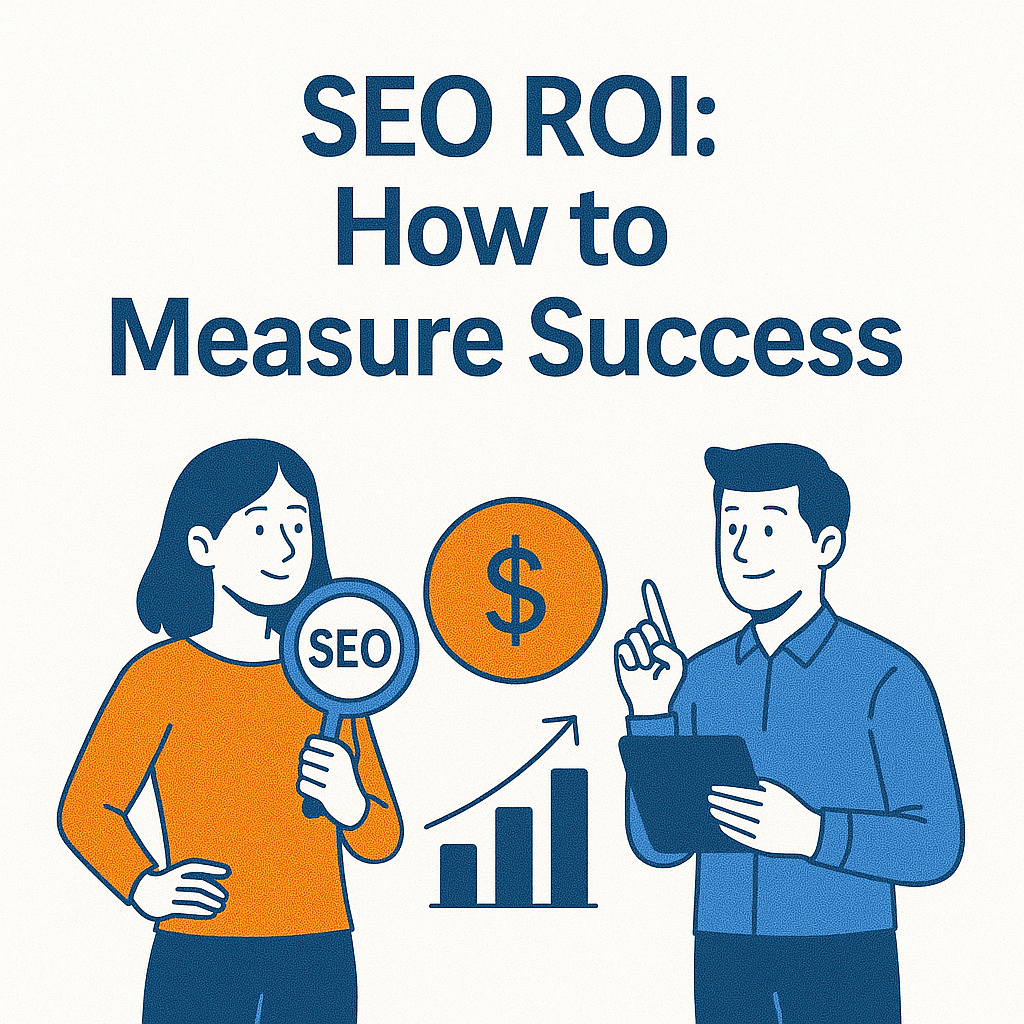
SEO ROI: How to Measure Success
Measuring the return on investment (ROI) of Search Engine Optimization (SEO) is one of the most crucial—and often misunderstood—tasks in digital marketing. Unlike PPC where you can directly correlate spend to clicks and conversions, SEO is a long-term strategy. Yet when done right, it produces exponentially higher ROI over time.
In this guide, we will break down every component involved in calculating and understanding SEO ROI so you can prove value, make data-driven decisions, and scale your efforts.
What is SEO ROI?
SEO ROI is a metric that evaluates the profitability of your SEO investments. It quantifies how much revenue you generate from SEO compared to how much you spend on it.
Basic Formula:
SEO ROI = (Revenue from SEO – SEO Costs) / SEO Costs × 100
Example:
Revenue from SEO: $50,000
SEO investment: $10,000
ROI = (($50,000 – $10,000) / $10,000) × 100 = 400%
This means for every $1 spent, you earned $5—$4 of which is profit.
Why Measuring SEO ROI is Essential
1. Demonstrate Business Value to Stakeholders
SEO often has a slower ramp-up than paid media. ROI helps you justify continued investment by showing long-term payoff.
2. Optimize Resource Allocation
By knowing which content types, keywords, or strategies drive the most returns, you can double down on what works and trim ineffective efforts.
3. Support Forecasting and Strategic Planning
Data-driven ROI analysis helps forecast future traffic and revenue growth, guiding budgeting and hiring.
4. Align SEO with Business Goals
Measuring ROI connects SEO performance to real business outcomes—like revenue, leads, and acquisition—not just rankings or traffic.
What You Need to Measure SEO ROI
To accurately calculate ROI, you need to track two core elements:
1. Revenue Attributable to SEO
This refers to how much income your website earns specifically from organic search traffic.
How you measure this depends on your business model:
A. E-commerce Businesses
Use platforms like Google Analytics 4 (GA4) or Shopify to track:
Organic traffic-driven transactions
Average order value (AOV)
Conversion rate from organic search
Example Calculation:
15,000 monthly organic visits
3% conversion rate
$90 AOV
Revenue: 15,000 × 3% × $90 = $40,500/month
Pro Tip: Use UTM parameters, GA4 ecommerce reports, and Google Search Console to validate organic origin.
B. B2B or Lead Generation Websites
Revenue isn’t instant—it’s tied to the lead lifecycle. Measure:
Number of organic leads
Lead-to-customer conversion rate (LTV-based)
Average deal or contract value
Example:
500 organic leads/month
10% convert to customers
$2,000 average deal size
Revenue: 500 × 10% × $2,000 = $100,000/month
Use CRMs like HubSpot or Salesforce with multi-touch attribution to track lead origins.
C. Media and Publishing Sites
Use Revenue per Mille (RPM) or eCPM to estimate ad-based revenue.
Organic Sessions: 100,000/month
RPM: $12
Revenue: (100,000 / 1,000) × $12 = $1,200/month
Connect Google Ad Manager with GA4 to improve accuracy.
2. SEO Costs
To measure ROI, you must account for every dollar spent on SEO. These include:
A. Internal Team Costs
SEO strategists
Content writers
Web developers (for technical SEO)
Design teams (for UX improvements)
You can estimate by calculating the percentage of salaries spent on SEO work.
B. SEO Tools and Software
Ahrefs, Semrush, Moz – for research and audits
Screaming Frog – for technical crawling
Surfer SEO, Clearscope – for content optimization
Keyword research tools
These can range from $100/month to several thousand annually.
C. Agency or Freelancer Fees
Monthly retainer or project-based SEO support
Outsourced link building
Content creation services
Track time spent and contract costs to calculate total spend.
D. One-Time and Miscellaneous Costs
Website redesign or migration
SEO audits
Landing page creation
Content refresh campaigns
SEO Metrics That Support ROI Analysis
Beyond revenue and costs, track supporting metrics to understand the effectiveness and efficiency of your SEO program.
| Metric | What It Tells You | Tools |
|---|---|---|
| Organic Sessions | How many users visit via search engines | Google Analytics, Search Console |
| Keyword Rankings | Visibility and SERP position | Ahrefs, Semrush, Moz |
| Click-Through Rate (CTR) | % of searchers who click your listing | Google Search Console |
| Bounce Rate / Engagement Rate | Visit quality and relevance | GA4 |
| Conversion Rate (CVR) | % of visitors who complete a goal | GA4, CRM |
| Time on Site / Pages per Session | Depth of engagement | GA4 |
| Goal Completions | Downloads, form fills, sign-ups | GA4 |
| Revenue Attribution | Direct income from SEO sources | GA4, Shopify, HubSpot |
Attribution Models and SEO
1. First-Touch Attribution
Credits SEO if the first visit was via search.
Ideal for top-of-funnel (ToFu) lead gen strategies.
2. Last-Touch Attribution
SEO is only credited if it was the final step before conversion.
May undervalue SEO in multi-step journeys.
3. Multi-Touch Attribution (Recommended)
Distributes credit across all touchpoints.
More accurate for complex, long sales cycles (e.g., B2B, SaaS).
Use tools like Google Analytics 4, Ruler Analytics, or HubSpot’s multi-touch attribution for a realistic view.
Tracking SEO ROI in Google Analytics 4 (GA4)
GA4 makes it possible to track and report ROI accurately:
Steps:
Set Up Conversions: Define key goals like form fills, purchases, or newsletter signups.
Use Source/Medium Filters: Filter conversions by
organictraffic in the acquisition report.Link to Google Search Console: Get keyword and CTR data alongside traffic.
Use Ecommerce Reporting: If applicable, track revenue from organic product listings.
Custom Reports: Use Explore > Free-form or Funnel reports to map user journeys.
Tips to Maximize and Prove SEO ROI
✅ Target High-Intent, Bottom-of-Funnel Keywords
Example: “Best CRM for startups” > higher conversion than “What is CRM”
Use Semrush or Ahrefs to find high-CPC, low-competition keywords.
✅ Invest in CRO for High-Traffic Pages
Optimize CTAs, page speed, and trust signals.
Add heatmaps (e.g., Hotjar) to understand user behavior.
✅ Implement Structured Data (Schema Markup)
Boost CTR with rich results like reviews, FAQs, and events.
✅ Repurpose and Update Existing Content
Refreshing old pages can improve rankings without creating new content.
Add internal links to support site structure.
✅ Benchmark Against Competitors
Use competitive intelligence tools to identify keyword gaps and backlink opportunities.
Spy on SERP features and content formats that outperform yours.
Real-World Case Study: SEO ROI Calculation
Industry: SaaS (B2B)
Monthly SEO Investment: $8,000
Team: $4,000
Tools: $1,500
Content creation: $2,500
Traffic Increase: 10,000 → 25,000 organic sessions/month
Lead Conversion Rate: 3%
Lead-to-Customer Rate: 10%
Average Customer Value: $3,000
Revenue:
25,000 sessions × 3% leads = 750 leads
750 × 10% customers = 75 customers
75 × $3,000 = $225,000/month
ROI:
($225,000 – $8,000) / $8,000 × 100 = 2,712% SEO ROI
Final Thoughts: SEO ROI is Not Just Numbers—It’s Strategy
Proving and improving SEO ROI means more than plugging in numbers. It requires:
Strategic planning
Smart tracking
Multi-touch attribution
Continuous testing and content refinement
Done well, SEO can become the most cost-effective channel in your entire marketing stack. Whether you’re presenting results to executives or building a strategy for scale, knowing how to measure and optimize ROI will set you apart.
Author



